Although white bird eggs with brown spots may seem unusual, they are actually found in lots of bird species. Some examples include barn and cliff swallows, eastern towhees, black skimmers, white-eyed vireos, turkey vultures, and others.
In this article, we will explain the main reasons why white eggs have brown spots, as well as the different bird species that are known to lay such stunning eggs. Whether you’re an avid bird watcher, farmer, or just someone that came across these eggs in their backyard, this article will provide you with the photos and the necessary information to identify them.
Table of Contents
Why Are Bird Eggs White With Brown Spots?
Bird eggshells are white because they are made of around 95% of calcium carbonate (the same compound that makes up seashells, corals, and pearls) while their reddish-brown color comes from a pigment called protoporphyrin. Another pigment called biliverdin produces shades of blue and green.
Scientists from Long Island University analyzed the eggs of 634 species and made an interesting discovery. Birds that live in colder regions that get less sun tend to have darker eggs while those found in warmer areas tend to have more variable but brighter eggshells.
Also, as a general rule, birds that nest in cavities will mostly lay white eggs.
Examples Of White Bird Eggs With Brown Spots
1. Prothonotary Warbler


Prothonotary warblers are small songbirds that breed from March to July in hardwood swamps of the eastern USA. They love to nest in cavities and will occasionally use old downy woodpecker or chickadee holes.
Males will start making several nesting sites but the females are the ones that make the final decision on which one to use and complete the construction. You will find their nests near or over standing water in bald cypress, willows, cypress knees, and sweetgum trees, several feet from the ground.
Prothonotary warblers lay 3-7 eggs and have 1-3 broods per year. Their eggs are white, spotted with rust-brown and lavender, and measure 0.8 inches long and 0.6 inches wide. They have an oval, smooth, and somewhat glossy shell.
Females will incubate the eggs for 12-14 days with both parents feeding the chicks. The young will leave the nest 10-11 days after hatching. Brown-headed cowbirds will sometimes parasitize the nests by laying eggs in warbler nests for them to raise their chicks.
2. White-eyed Vireo

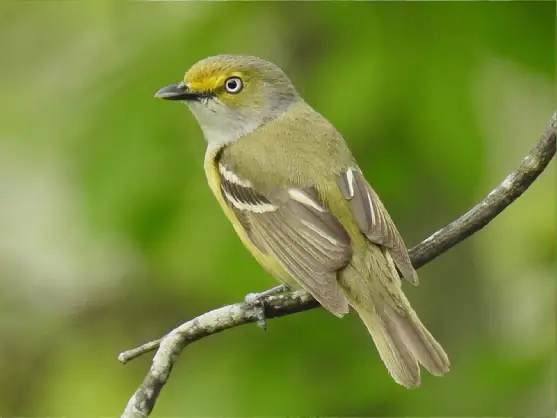
White-eyed vireos are other small songbirds found in eastern parts of the USA. In the States, they breed from New England west to northern Missouri and south to Texas and Florida; their breeding season lasts from April through August.
If you come across a cup-shaped nest that is lined with grass and attached to a fork in a tree branch by spider webs 2–6 feet above the ground, there’s a good chance that it is from these birds. Both partners participate in building the nest and it will take them from 3 to 5 days to complete it.
White-eyed vireos lay 3-5 dark-spotted white eggs that both parents incubate for 12-16 days. The eggs are 0.8 inches long and 0.6 inches wide.
The pair will also feed the nestlings and their young leave the nest around 10 days after hatching. Populations living in the north will have 1 brood per year while southern ones will have 2.
3. Eastern Towhee
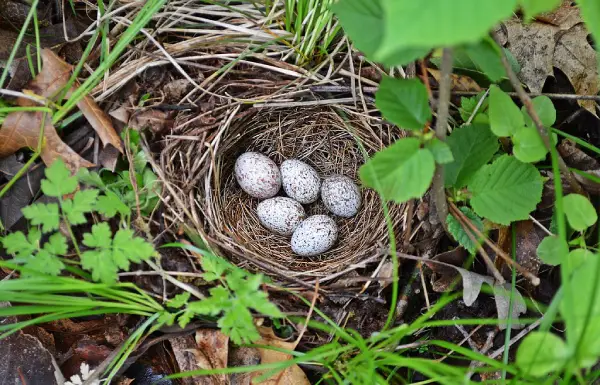
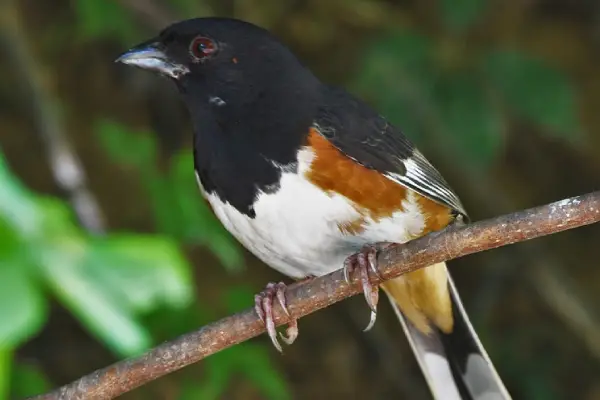
Eastern towhees, large New World sparrows, are found in brushy areas across eastern North America. They breed in the northern parts of the USA and then move south for the winter; eastern towhees will nest either low in bushes or on the ground under shrubs.
Females are the ones that build their 4-inch wide nests using twigs, leaves, tree bark, and animal hair to line everything up. It takes them around 5 days to finish everything.
Eastern towhees lay 2-6 eggs several times per year (1-3 broods). Their eggs measure 0.9 inches long and 0.8 inches wide; they are mostly creamy white with reddish-brown spots and speckles concentrated on one end.
Most females lay their eggs around August and will spend 12 to 13 days incubating them. After hatching, both partners will feed the young – they leave the nest after around 11 days and depend on their parents for another month.
Just like with many birds from this list, brown-headed cowbirds will also lay their eggs in towhees’ nests; towhees show no ability to recognize or remove the imposters and will incubate the eggs and rear the cowbird hatchlings as their own.
Different animals will prey on eastern towhee eggs, including northern raccoons, domestic cats, eastern chipmunks, bullsnakes, rat snakes, weasels, various owls and hawks, and blue jays.
4. Tufted Titmouse

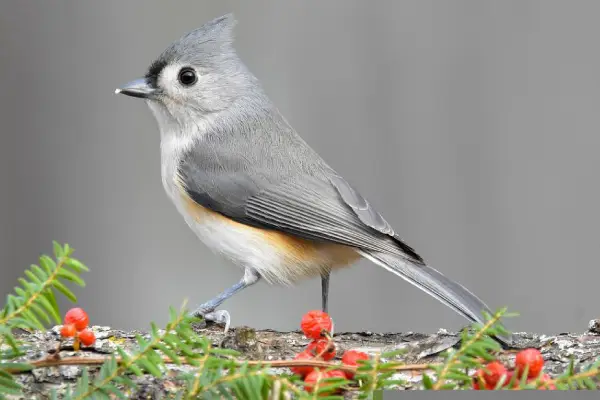
These small gray North American songbirds are common in deciduous and mixed woods, orchards, parks, and suburban areas. They are cavity nesters but can’t excavate them on their own. That’s why they use tree holes, either in natural cavities or those made by woodpeckers; including man-made nest boxes and fenceposts.
Titmice will place their cup-shaped nests a few feet from the ground and will use leaves, moss, grasses, bark strip, wool, and cotton. They might also pluck hair from dogs, woodchucks, and even humans.
Look for their eggs from April to June; tufted titmice lay 3 to 9 white eggs that are spotted with chestnut-red, brown, and purple. The eggs are 0.7 inches long and 0.6 inches wide and females will incubate them for 12 to 14 days.
During this period, males will feed them; the pair might also have “helpers” from last year’s brood that aid with raising the young. After 15 to 16 days the young will fledge; some will stay with their parents during the winter and even a year after hatching.
5. Barn Swallow

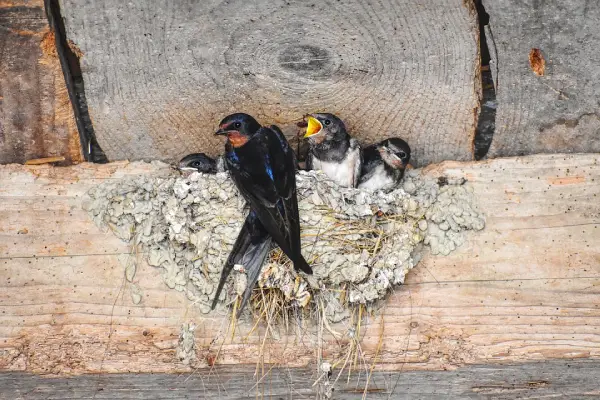
Barn swallows are one of the most widespread swallow species in the world. These tiny birds with notched tails are breeding residents throughout the USA and love the open country with low vegetation.
They’ve had a close relationship with humans and have spread with our expansion. Although they originally used sheltered crevices in cliffs or shallow caves, as the name suggests, modern barn swallows will build their cup-shaped nests using mud pellets around barns, eaves, bridges, docks, and similar structures.
Barn swallows are monogamous and stay together for life; both partners will participate in building the nest. As it might take them almost 2 weeks to complete it, some barn swallows might just use their last year’s nesting site. When reusing old nests, they will remove old feathers and add new mud to the nest’s rim.
Barn swallows lay 3-7 creamy white eggs spotted with brown and gray. They are ovular instead of elliptical and measure 0.7 inches long and 0.5 inches wide and weigh just 0.07 oz.
Both parents incubate the eggs for 13 to 17 days and feed the young with the help of 1 or 2 of last year’s offspring. Young will leave the nest around 18 to 23 days after hatching; barn swallows might lay eggs once or twice a year.
Around 90% of eggs will hatch and 70-90% of fledglings will survive. In North America cowbirds might parasitize their eggs; in Europe and Asia, cuckoos do that.
6. Brown-headed Cowbird
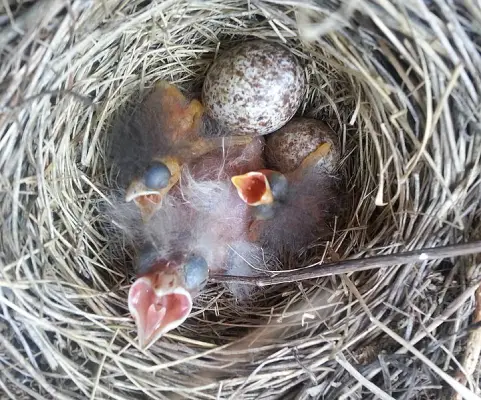
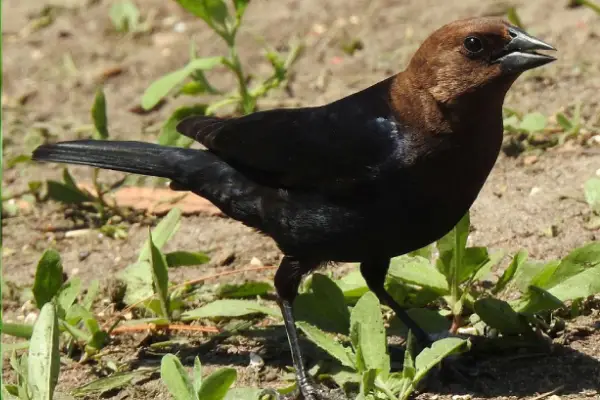
Brown-headed cowbirds are small black brood parasitic birds found throughout North America. They will lay their eggs in the nests of others, sparing themselves the trouble of rearing their own young; scientists documented over 140 bird species hosting their eggs, ranging from tiny kinglets to raptors.
Brown-headed cowbirds do not build their own nests. They will instead lay 1-7 white to grayish-white eggs with brown or gray spots – up to 36 per season! Their eggs measure 0.9 inches long and 0.7 inches wide.
Not all host birds are like eastern towhees and some will notice that there’s something wrong with their nest. Blue-grey gnatcatchers will simply leave their nest, abandoning cowbird together with their own eggs in the process. American yellow warblers will just build another nest on top of cowbird eggs while brown thrashers just throw cowbird eggs out of the nest.
In case you spot a cowbird egg in another bird’s nest, do NOT remove it.
Brown-headed cowbirds are protected under the Migratory Bird Treaty Act as they are native species, and taking eggs is illegal if you do not own a permit. Since many birds keep track of the total number of eggs in their nests, some might leave their eggs and nests completely and find a new nesting spot. Finally, if you remove their egg from a nest, brown-headed cowbird mothers resort to what is known as “mafia behavior” and return and damage the nest, destroying most of the remaining eggs.
Discover: What birds lay red-speckled eggs?
7. Black Skimmer

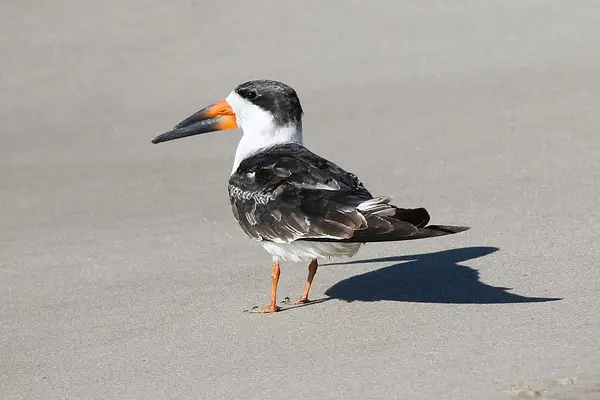
Black skimmers are large black tern-like seabirds with some of the most unique bills you will ever see. Their lower mandible is longer than the upper to allow them to skim along the water surface and catch fish.
Black skimmers can be seen from the coasts of the northeastern United States, down to Mexico, and over to the Gulf Coast of Florida, with their breeding range spanning from southern California all the way to Ecuador.
Black skimmers lay eggs directly on small scrapes or depressions in the sand, usually from mid-May to early June. They nest close to tern colonies which helps protect their eggs as terns attack gulls and mammals that prey on eggs and chicks.
Black skimmers lay 1-5 eggs that measure 1.5-2 inches long and 1.2-1.4 inches wide. Their eggs are pale creamy white with dark brown spots.
Both partners will incubate the eggs (males may do more) for 21 to 23 days and also take turns in feeding their young, by regurgitation. Unlike their parents, the young have mandibles that are of the same length at first which helps them pick up the food their parents dropped on the ground more easily. After 23 to 25 days, the young will have learned how to fly.
Black skimmer egg predators include raccoons, crows, opossums, coyotes, and feral hogs. Due to their beach nesting habits, people, pets, and predators might disturb black skimmers, forcing these birds to stop nesting or completely abandon eggs and chicks.
Read More: What are some birds that lay green eggs?
8. Turkey Vulture

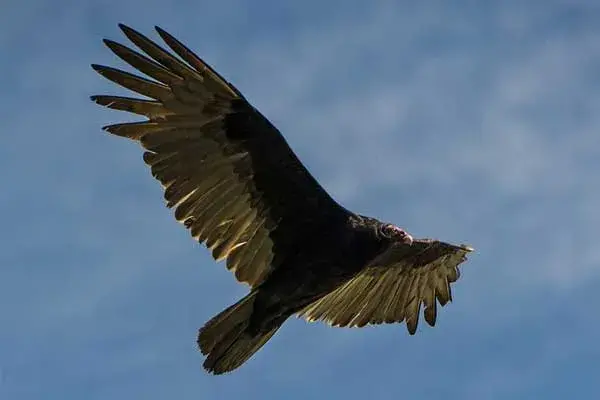
With a wingspan of around 6 feet, black-brown plumage, bare red heads, and white legs, turkey vultures are hard to miss in the sky. The same can be also said for their eggs.
These massive raptors lay from 1 to 3 creamy white eggs tinged with gray, blue, or green, and blotched with brown and purple. They have rather large eggs measuring 2.8 inches long and 1.9 inches wide that both parents incubate for 34-41 days.
Both of them will also feed the young by regurgitating food; the young defend themselves by hissing and regurgitating. Young turkey vultures fledge 60-80 days after hatching.
Their parents do not build full nests and mostly lay their eggs on debris or on the flat bottom of the nest site. Although they feed on carrion near humans, turkey vultures prefer to nest far away from urban areas.
They are protected under the Migratory Bird Treaty Act which makes it illegal to take, kill, or possess turkey vultures or their eggs. The biggest natural threats to their eggs are raccoons and opossums.
Read More: Examples of red-colored bird eggs
9. Western Meadowlark
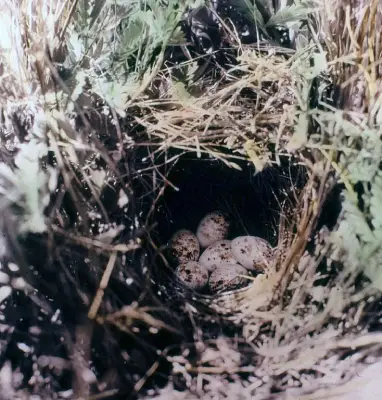

Western meadowlarks are medium-sized songbirds that nest on the ground in open grasslands across western and central parts of North America. They are state birds of Kansas, Montana, Oregon, Nebraska, Wyoming, and North Dakota.
Female western meadowlarks build their nests on the ground and cover them with roofs woven from grass; due to such hidden nature, people might accidentally destroy their nests while mowing or hiking. A single male might have several females nesting in his territory and after a week of work, the finished nest will measure 7-8 inches wide and 2-3 inches deep.
Western meadowlarks lay 5-6 white-colored eggs heavily spotted with brown and purple, especially at the larger end. They lay eggs at daily intervals and the eggs measure around 1.2 inches long and 0.9 inches wide.
Females will incubate them for 13-15 days and chicks will hatch altricial (underdeveloped) and nearly naked. Young fledge after around 11 days and begin flying on their own after 3 weeks.
Brown-headed cowbirds will often replace meadowlarks’ eggs with their own for these birds to raise.
Read More: List of North American birds that lay blue eggs with brown spots
10. Cliff Swallow
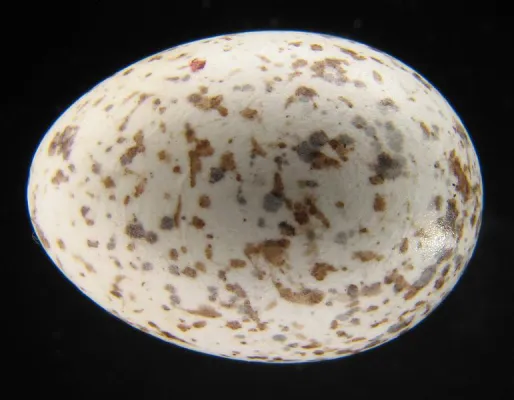
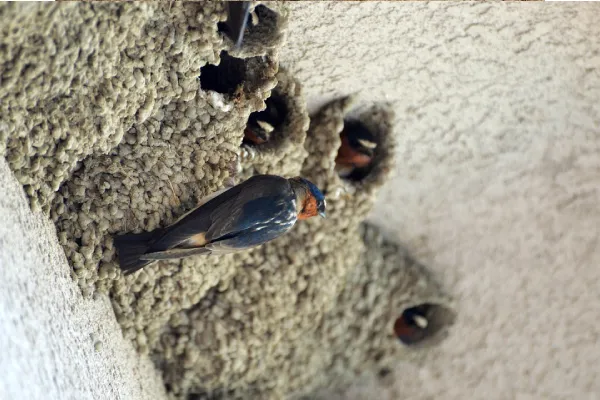
These very social songbirds can be seen in large nesting colonies with over 2,000 nests across most of North America. You will recognize their gourd-shaped nests made of mud with a small entrance on the side. Cliff swallows love to build their nests close together, most commonly under bridges and mountain cliffs.
Both partners will build the nest and line the insides with grass and feathers. Some individuals will repair and reuse old nests. Typical nests measure around 8 inches long, 6 inches wide, and 4.5 inches deep.
Cliff swallows lay 1-6 eggs once or twice a year. Their eggs are white, creamy, or pinkish, with brown and gray speckles or blotches, and measure 0.8 inches long and 0.5 inches wide.
Both parents will incubate their eggs for 14 to 16 days and will also take care of the chicks after hatching; the young leave the nest after 21-23 days.
One interesting observation is that females lose feathers on their lower breasts during incubation to create a warm patch while sitting on their eggs. The species may also move or lay their eggs in other neighboring nests. Females that brood-parasitize will spend less energy on nurturing chicks and thus increase their reproductive success.
Some birds, like house sparrows, might search several swallow nests to find a great place for their own, destroying their eggs in the process.
Read More: What are some blue speckled bird eggs?
Summary
Bird eggs can have various large or small brown spots or markings on their white shells. Such markings come from various pigments, range in color and size, and can be found on eggs laid by a variety of bird species. Some of the most common white bird eggs with brown spots include those laid by vireos, towhees, titmice, swallows, vultures, and others.
If you enjoyed this article, feel free to check out our photo guide on brown-speckled bird eggs and our photo guide on eggs laid in rocks.